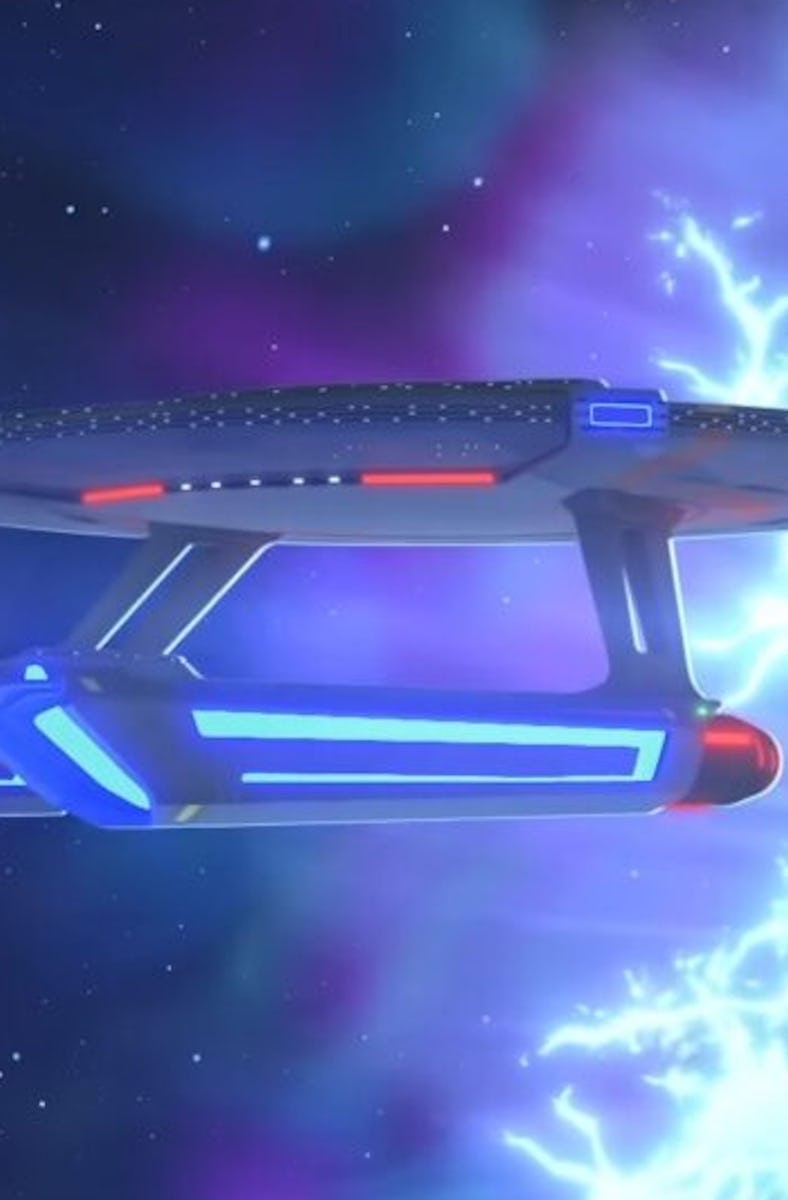Star Trek Just Revealed a Possible Fix to an Eternal Canon Problem
Could we really tell if we were seeing an alternate timeline? Are you sure?

Before the multiverse became a whole thing, the Star Trek franchise has been introducing parallel and divergent timelines for decades. While the 2009 J.J. Abrams Trek movie might have made a big deal about skewered timelines — holding the audience's hand like Doc Brown drawing a diagonal line on the chalkboard — overlapping realities are almost mandatory to our understanding of the Trek timeline. When Kirk and Spock “restored” the timeline in “The City on the Edge of Forever,” they also created two others: One in which the Federation never existed, and a new one, in which they now are an integral part of Earth’s past.
But rebooting the present (or the future) throughout the Trek canon leads to an interesting question. Would we ever really know if we’re watching the same Trek timeline episode-to-episode or movie-to-movie? What if the differences between timelines were so small, that we couldn’t tell? The first episode of Lower Decks Season 5 suggests that maybe we wouldn’t.
Spoilers for the Lower Decks Season 5 premiere ahead.
Two versions of the Cerritos crew clash. But which one is “real?”
In “Dos Cerritos,” the USS Cerritos encounters another version of the Lower Decks from an alternate universe that is only slightly different from the “Prime” universe. The uniforms are colored a slightly, almost imperceptible darker hue; T’Lynn likes to say “remarkable” instead of “fascinating;” Mariner uses her last name, “Freeman,” rather than going by her middle name; and Billups proudly wears his cape, associated with his role as a royal member of the kingdom Hysperia. And, as T’Lynn explains, “According to scans, the quantum signatures of the parallel crews exhibit a mere .327 percent variance.”
Later, we learn that the biggest variance is that in this timeline, Mariner has become captain, and her mother, Carol, has been sent to work on the dreaded, run-down Starbase 80. But, as the “other” T’Lynn further asserts, these universes are only “negligibly divergent.” In the same scene, one version of Ransom says “Hey, this is the Prime Universe!” These jokes continue throughout the other episode with jokes about “the fake Cerritos,” and Rutherford referring to his counterpart as “Otherford.”
And yet, despite the humorously dark turn that the other Mariner takes toward the end of the episode, it’s fairly easy to imagine all of the existing TNG/DS9/Voyager canon taking place within the timeline of the other Cerritos, just nothing we can actually see because we’re only focused on this one ship and crew.
Various versions of the Enterprise in the TNG episode “Parallels.”
In fairness, this is not an entirely new idea for Trek. In the TNG episode “Parallels,” Worf is shifting between realities, which at first, are only negligibly divergent from his own. Data’s birthday gift to him is slightly different in one universe than another, Captain Picard attends his party in one universe and not another, and suddenly, that explodes into countless Enterprises including Riker with a bushy beard, a world in which Captain Picard is deceased, and so on.
Thanks to this kind of fun and arresting imagery, fans tend to think harder about the universes that are clearly different, and less about the ones that aren’t that different. And it’s in this small thought experiment that Lower Decks is making an interesting point. You could easily watch an episode of any given Star Trek show, have that episode set in a slightly different parallel universe, and perhaps never notice. Think about it. If some episodes of TOS and TNG simply take place in mildly divergent universes from one another, then suddenly, a lot of continuity errors aren’t errors at all. In early TNG episodes Beverly calls Picard “Jean” and not “Jean-Luc,” and Deanna calls Will Riker “Bill.” The Watsonian explanation is easy: TNG hadn’t figured out its own internal consistency in the writers’ room. But the Doylist take is arguably more interesting: Each of these canon hiccups presents a mildly different timeline.
Once you accept that premise, suddenly, a lot of Star Trek’s wonky inconsistencies start to smooth themselves out. Different uniforms start making more sense, Spock’s family tree sorts itself out, and Khan’s memory of meeting Chekov before Chekov was even on the original TV series totally works, because hey, maybe that was a slightly different parallel universe, too.
To date, “Dos Cerritos,” is one of the better Star Trek alternate universe episodes, and not just because it’s very funny. It also maybe, just maybe, gave us a new way of thinking about fictional multiverses which is both mind-blowing and relaxing simultaneously.